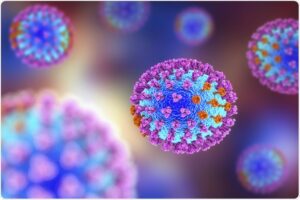What is the immune system?
The immune system is the set of physical, physiological, molecular and cellular mechanisms by which an organism, including humans, defends itself against threats such as viruses and bacteria. It consists of two main components that are referred to as innate immunity and adaptive immunity.
What is innate immunity?
Innateimmunity encompasses a range of defensive barriers: anatomical (such as skin and mucous membranes), physiological (such as temperature and pH), molecular (e.g., interferons and complement proteins), and cellular (mediated by different cell types, e.g., macrophages and Natural Killer cells). These mechanisms are present from birth and are the first to counteract any dangers. Innate immunity is a fast and powerful type of immune response, but it is not specific and does not “remember” threats faced in the past.
Examples of mechanisms of innate immunity are coughing and sneezing, mucus, enzymes contained in tears, and the acidic pH of the stomach-systems designed to keep out potentially dangerous antigens or destroy them before they can do harm. Interferons are part of humoral innate immunity: they are proteins of the cytokine family that, as the name suggests, interfere with viral infections and enhance the action of immune cells such as macrophages. The latter, by engulfing potential pathogens and cellular debris, are the scavengers of the immune system.
What is acquired immunity?
If pathogens succeed in overcoming the body’s first lines of defense, then the mechanisms of acquired immunity (also called adaptive or specificimmunity ) intervene. It is therefore a delayed immune response, but it has the advantage of being specific and retaining the memory of battles already fought, so that it is activated soonerr and more effectively in case of future encounters with the same pathogen. Acquired immunity is based on the activation of B lymphocytesLymphocytes are the cells that make up the effective portion of the adaptive immune system; they are able to generate and modify antibodies that will recognize antigens in the future. They are present in primary lymphoid organs, secondary lymphoid organs, peripheral blood and lymph (where they are currently named). andT lymphocytes, i.e., cells that are highly specialized precisely to fight infection, in different ways.
What are B lymphocytes and what are they used for?
B lymphocytes are cells with immune functions. Present in the bone marrow, spleen and lymph nodes, they perform multiple functions. They mediate the action of T lymphocytes by intercepting, thanks to a receptor on their surface (Bcr), the antigen for which they specialize and presenting it to T cells so as to activate them. B lymphocytes also release cytokinesCytokines are small proteins produced by the immune system, which bind to specific receptors present on the cell membrane and communicate to the cell a specific set of instructions such as, for example, the stimulus to grow, or to differentiate or even the order to die. They are produced by different types of cells and, once released in the body, induce specific reactions in adjacent cells (paracrine effect), in others far away (endocrine effect) or in those that have created them (autocrine effect)., but the function for which they are best known is the production of antibodies, which are proteins that serve as a “molecular tag” that binds to the antigen by signaling to the other components of the immune system the presence of the pathogen to be eliminated. Antigen-antibody binding is one of the keys to successful acquired immunity.
When it intercepts the antigen for which it is specific, the B lymphocyte is activated and within 48 to 72 hours it prepares for antibody production, matures and multiplies, taking the name plasma cell. Plasma cells produce specific antibodies until the infection is eliminated, then most die. Some, however, survive by becoming memory B lymphocytes, that is, those cells that keep track of the defeated enemy and in the event of new aggression initiate a faster and more effective secondary immune response.
What are T lymphocytes and what are they used for?
T lymphocytes are effector immune cells, i.e., deputed to directly counter the threat (whether it is a pathogen, toxin, or cancer cell). T lymphocytes are also specialized cells and recognize a particular antigen. When such an antigen is present, they become activated and proliferate. There are actually multiple types of T lymphocytes: helper T lymphocytes (or CD4+) and cytotoxic T lymphocytes (or CD8+).
T helper lymphocytes are adjuvants: they produce cytokines that serve to activate other T lymphocytes and stimulate B lymphocytes to produce antibodies. Within the T helper lymphocyte group, then, two subtypes called Th1 and Th2 can be distinguished. Th1s produce proinflammatory cytokines (e.g., interferon gamma) and together with cytotoxic T lymphocytes support a very powerful immune response that, if not modulated, can degenerate into chronic inflammation and damage the body. Th2s, on the other hand, together with plasma cells, promote an immune response that is considered anti-inflammatory. Thebalance between Th1 and Th2 responses produces an effective immune reaction that is at the same time not excessively harmful to the body.
Finally, cytotoxic T lymphocytes are storm troopers: their role is to attack and neutralize threats by punching holes in the cell wall through particular proteins. Once the threat is eliminated, the T lymphocytes do not die immediately, but retreat into the lymph nodes and become memory T cells, able to intervene promptly should the threat reoccur.







